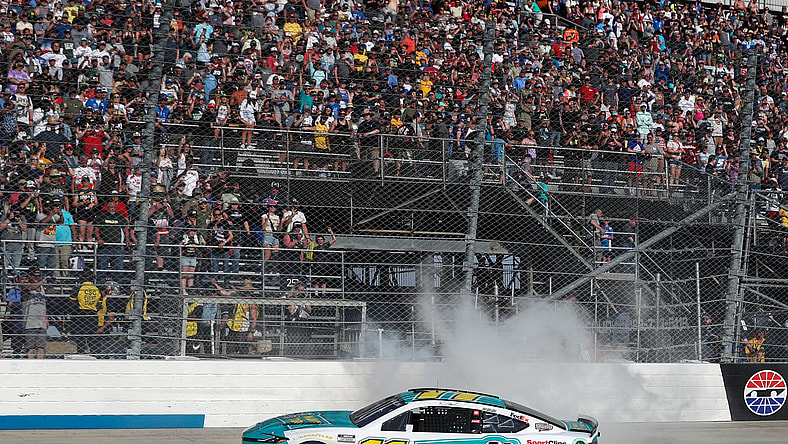
In NASCAR, every fraction of a second counts, and teams are always looking for ways to gain an advantage over each other. With most of the focus on aerodynamics, engine power, and driver skill, one parameter of a race car’s setup is tire pressure. “Bleeding tires” is a term that’s circulated in the racing community, but what does it mean?
What is Bleeding Tires in NASCAR?
‘Bleeding tires’ in NASCAR is the term used for the adjustments made to tire pressure for better performance during a race. Teams constantly check the tire pressure during the race because it can have a great impact on handling and grip.
During a race, tires heat up because of contact with the track surface; so the air inside the tire expands, and as a result, tire pressure increases. If the pressure becomes too high, it will affect the car’s control, and the result could be reduced performance or even tire failure.
When “bleeding,” teams let go of some of the air pressure from the tires to keep it at an optimal level. This is normally done during pit stops or caution periods when teams can make alterations to the car.
Also Read: NASCAR schedule – Races today, this weekend and track info
The NASCAR regulations on tire pressure are formulated to achieve balanced competition, safety, and fair play. Here’s an overview of what is usually permitted and what is not:
What is allowed?
- Optimizing Tire Pressure for Performance: Tire pressure can be adjusted by teams within the prescribed limits in order to enhance performance on different tracks. The lower pressure may also provide a better grip on wet surfaces, while higher pressure would be advisable on rough tracks.
- Monitoring and Adjusting During Pit Stops: While making pit stops, tire pressure is monitored by tech systems, and modifications are done as well. This helps them embrace the changes as well as maintain a high performance level.
What is prohibited?
- Intentional Deflation or “Bleeding” Tires: Intentionally underinflating tires outside the specified limit or employing methods by which to lower the pressure on tires is absolutely prohibited during a race. This involves the use of tools or equipment to get air out of the tires to gain an unfair advantage.
- Tampering with Tire Pressure Sensors: Nowadays, in NASCAR, tire pressure sensors are required for tire health and performance monitoring. Interfering with these sensors or altering their readings to fool the officials or to obtain undue advantage is prohibited.
- Using Illegal Tire-Soaking Substances: Some teams have tried to cheat by soaking tires in liquids such as chemicals or sealants, which would change the properties of the rubber. This practice is unlawful and carries a fine, suspension, and even disqualification.
NASCAR allows teams to adjust tire pressure within certain limits in order to maximize performance but prohibits any intentional manipulation or tampering that might give an unfair advantage or compromise safety.
Also Read: NASCAR power rankings: Find out where Denny Hamlin, Kyle Larson and others rank
Who Got Caught For Bleeding Tires In NASCAR?

During the 2015 season, Richard Childress Racing (RCR) found itself in trouble with NASCAR after tampering with tires. They tried to extend the life of their tires by gradually releasing air; in fact, they were bleeding them. However, NASCAR stated this was against the regulations, and RCR was severely penalized.
RCR lost points, had to pay a $125,000 fine, and some team members were suspended.
In another incident, more recently in 2023, Ty Majeski, who was racing for ThorSport Racing in the Truck Series, had problems with NASCAR. At the Milwaukee Speedway pre-race inspection, they found the irregular valve stem cap on one of his truck’s wheels. This cap would help vent air out of the tire during the race, which could be an advantage. NASCAR did not take it lightly, and Majeski was penalized with L2-level penalties, which included the loss of points and payment of fines.
Also Read: How to watch NASCAR races in 2024
Bleeding Tires NASCAR Rules
NASCAR has in its rule book specific guidelines about tire tampering with sections that say what cannot be done.
According to Section 20.16.1 of the NASCAR rulebook, “Any device, modification, or procedure to the tire or wheel, including the valve stem hardware, that is used to release pressure, beyond normal pressure adjustments, from the tire and/or inner shield, will not be permitted.” Similarly, Section 20.16.2 states, “Modifications to the tires, by treatment or any other means, will not be permitted.”
If teams do not follow these rules, they will be deducted points, fined, or even suspended. This proves that NASCAR is determined to maintain competition fair and safe without any exceptions.
The practice of bleeding tires is still an issue in NASCAR, as the teams are always looking for new ways to get an edge within the limits of the rules.
Also Read: 20 richest NASCAR drivers of all time – Where does Dale Earnhardt Jr. land in the top 20?